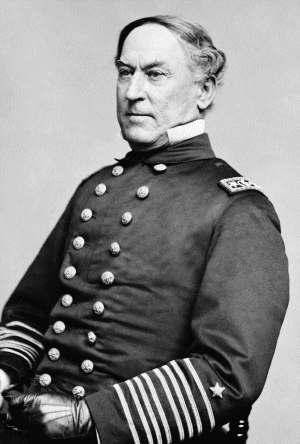 David Glasgow Farragut David Glasgow Farragutthe first Rear Admiral and the first
full Admiral in U.S. history
James Glasgow Farragut was born
near Knoxville, Tennessee, on July 5, 1801, the
son of Jorge and Elizabeth Farragut, and grew up
in New Orleans. His mother died in 1808. His
father was a close friend of the father of future
Commodore David Dixon Porter, and, after the elder Porter died in
1810, David Porter offered to adopt James and
train him as a naval officer in gratitude for
everything Jorge had done for his father; James
changed his name to David to honor his adopted
father.
A midshipman at the age of
nine, Farragut subsequently served under Porter
on the USS Essex during the War of 1812,
including during a battle against two British
warships. After the war, he took time to receive
some formal education before spending four years
in the Mediterranean. He passed the Lieutenant's
exam in 1820, fought pirates in the West Indies
1822-1824, and was promoted to Lieutenant in
1825. In 1824, he was posted to the naval yard at
Norfolk, Virginia; he met and married Susan
Marchant there that same year.
Farragut stayed at Norfolk
until 1832, when he was posted to service off the
Brazilian coast. He subsequently returned to
Norfolk, and was promoted to Commander in 1841.
Susan Farragut died in 1840. In 1843, he married
Virginia Lloyd, who gave him a son, Lloyd, in
1844. He spent the Mexican-American
War as commander of the
USS Saratoga, but saw no major action.
In 1854 he helped establish Mare Island Navy Yard
in San Pablo Bay, near San Francisco, and he
performed that job so well that he was promoted
to Captain in 1855; he was recalled to Norfolk in
1858.
As the outbreak of Civil War became evident, Farragut was pressured
by his friends and neighbors in Norfolk to join
the Confederate cause, but he felt too much
loyalty toward the U.S. Navy. Fearing that he
could well be in danger if he stayed in Norfolk,
he gave up his home, moved his family to New York
City, and offered his services to the Union. His
offer was accepted, and he took command of the
Western Gulf Blockading Squadron in 1862. On
April 24, 1862, he ran his fleet between heavy
shelling from Forts Jackson and St. Philip to
force the surrender of New Orleans. He then
sailed up the Mississippi River with heavy
seagoing ships to bombard Vicksburg, capturing
Baton Rouge and Natchez along the way. In
recognition of these achievements, Congress
created the rank of Rear Admiral and promoted
Farragut to that rank. On August 5, 1864,
Farragut's fleet was preparing to engage a
Confederate fleet in Mobile Bay when the lead
ship was struck by a torpedo and sunk. When the
remaining ships stopped their progress, Farragut
yelled out "Damn the torpedoes. Full steam
ahead!" and ordered the fleet to continue
into the bay. Despite facing fire from two forts,
the fleet did as it was ordered and by the end of
the day had defeated the Confederate fleet, and
had also forced the surrender of both forts; the
city of Mobile,
Alabama later fell to land
troops.
By December of 1864 Farragut's
health was failing and he was ordered to return
to New York and rest. President
Abraham Lincoln
promoted him to Vice-Admiral on December 21,
1864, and Congress made him the first full
Admiral in U.S. history in 1866. In 1867, he was
given a ship and "ordered" to visit
various European capitals. He died of a stroke
while vacationing at Portsmouth, New Hampshire,
on August 14, 1870, and was buried at Woodlawn
Cemetery in New York City.

Tennessee History for Kids http://www.tnhistoryforkids.org/people/david_farragut/

David Dixon
Porter
War of 1812
Mexican-American War
Civil
War
Mobile,
Alabama
President
Abraham Lincoln
Questions or comments about
this page?
|



